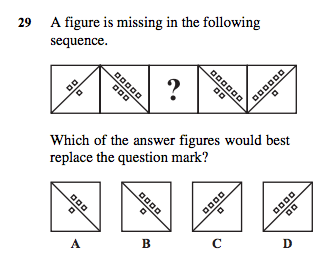17. Numbers in patterns
Sometimes number patterns occur in abstract reasoning. The numbers are usually represented by a visual symbol e.g. a dot or a line.
Number patterns appear in abstract reasoning because they are represented by imagery. However, in essence, you should treat them as numbers whenever you suspect it involves number patterns and quantity of images.
Such types of number patterns are:
- Increasing via addition, multiplication or other combination.
- Decreasing via subtraction, division or other combination.
Because abstract reasoning involves visual pattern detection, let’s apply this to the following question/s.
Example Question/s
Watch video for explanation of the following question/s:

Source: http://www.schools.nsw.edu.au/media/downloads/schoolsweb/learning/k_6assessments/ss/gatest4.pdf
Why is this abstract reasoning question really a number pattern?
- It has quantities of dots.
- There's no visually evident pattern e.g. no repetition that would hold true.
- Therefore, look at the pattern for numbers.


Key Rules to remember
- Identify that a number pattern is occurring when there are multiple quantities of a particular image.
- Increasing via addition, multiplication or other combination.
- Decreasing via subtraction, division or other combination.
Practice time!
Now, it's your turn to practice.
Click on the button below and start your practice questions. We recommend doing untimed mode first, and then, when you're ready, do timed mode.
Every question has two solutions videos after you complete the question. The first is a quick 60 second video that shows you how our expert answers the question quickly. The second video is a more in-depth 5-steps or less explainer video that shows you the steps to take to answer the question. It's really important that you review the second video because that's where you'll learn additional tips and tricks.
Once you're done with the practice questions, move on to the next checkpoint.
Now, let's get started on your practice questions.
10 questions
Take a Timed Test Take an Untimed Test